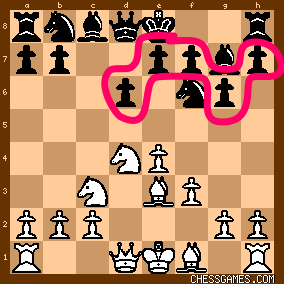You know how crazy I get about connections and analogies.
They’re the foundation for creativity and where genius is born.
I get a boner when it involves cross-pollination of multiple fields – and it’s even sexier when it comes from a single person (a.k.a. a polymath).
Today’s case is an intriguing link between chess and astronomy.
The chess opening known as the Sicilian Dragon was aptly named from its uncanny resemblance to the star constellation Draco.
Fyodor Dus-Chotimirsky, the Russian chess master who coined the Dragon, was also an amateur astronomer.
Take a look at the black queenside pawn structure – the pawns on d6,e7,f7,g6 and h7 form the fearsome dragon shape.
The name is equally fitting because besides having the most badass name, the Sicilian defence is one of the strongest and highest scoring openings for black in response to white’s king pawn opening 1. e4, with 1. …c5.
The dragon variation of the Sicilian defence takes it a step further by “fianchettoing” the queenside bishop onto the g7 square, into the pocket made by the pawns.
This “Dragon Bishop” as it’s known, eyes down the dark square long diagonal and breathes fire down on white’s kingside. It’s ready to lash out anytime and is a force to be reckin’ with. Ferocious indeed.
To stretch this analogy even further, it’s said that the tail of the Draco constellation protects the little dipper, a.k.a. Ursa Minor, or “little bear”. That tail is where the Dragon Bishop is – too cool.

I’m sure he will Mr. Malfoy
Check out this short 4 minute video on the Draco constellation for more info.
It’s crazy how people geek out on these kind of things – which also reminds me how little I know about astronomy and space. Seeking as we’re not too far from the space age (hello Elon Musk!), it’s probably a great thing to put on the learning list.
29/08/15: Return of the king (or in my case, the pawn)
After more than a 10 year hiatus with chess, I’ve gotten back into it after realizing that I haven’t gotten better even though I’ve played it for many years. This exemplifies the idea of deliberate practice – putting more hours into practice is not the answer, its QUALITY of practice (purposeful practice at the edge of ability) that truly counts.
Everyone starts off playing chess games for the fun of it, but like any other craft, to reach mastery level you must study the theory and drill the drills. In chess this comes down to breaking the game down into its parts (tactics, openings, end game etc.) and practicing them individually.
Chess was one of my favourite games as a kid. I remember playing on the school chess team and getting geeked out about it when I was in 6th grade. Though I was introduced to basic theory, I never immersed myself into chess to the depth that I needed to to be truly great. I couldn’t understand why people went so far as studying other people;s games, and I thought all the different types of openings were a hassle to learn. Furthermore, the algebraic notation (1. e4 1. …c5 etc.) was too hard for me to follow. Now, looking back I see the beauty and depth I was missing out on.
Recently, I started playing again with a friend I haven’t seen since my chess days (Hi Max!) and my interest in flow and expertise has compelled me to see if I can get better at this game. It was a tad embarrassing to find out that I didn’t even qualify as a “beginner” on Chess.com (You need a >1400 score). I thought I was decent, if not NOT a beginner.
Oh well, Dunning-Kruger effect in full effect: we don’t know how much we suck at stuff when we are sucky at it.
This revival in this old pastime is exciting. Part of the motivation is due to the fast that the intelligentsia of many cultures play chess (Bill Gates, Albert Einstein etc.) and that it may provide a connection point for rapport should I ever need it. The other is influenced by my love of learning and skill acquisition; this lets me explore chunking, pattern recognition, expertise, and let’s me interact with high performers.
The flow states I experience playing chess is unmistakable, partly due to the fact that I’ve put in enough hours in the past to the point where all the beginner hassle are no more. I LITERALLY can play for hours without getting tired, without sleep – sometimes pulling all-nighters.
My plans are to get to at least 1800 in my lifetime, possibly cracking the 2000s and getting a title (Grandmaster would be cool – Optimistic :P). I see myself as an old geezer playing chess in the cafe and park.
It’s crazy to imagine that this game of kings will still be enjoyed for many centuries to come. Even more astounding when you realized that this you’ve been playing a game that people have been playing for centuries – a game that has been pretty much unchanged for generations and you’re continuing on the tradition, adding another rung onto the ladder.
All the best in chess and life,
-David Wu

More chess related blogs to come – if you want to play a game, or have any tips for me on how to improve, shout out to @IamDavidWu




Hi David, it seems you are swapping “queenside” and “kingside” all the way through your description of the sicilian dragon. 😉
LikeLiked by 1 person